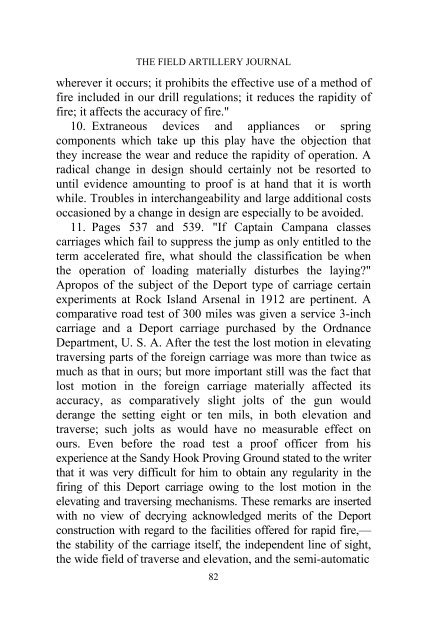the field artillery journal - Fort Sill - U.S. Army
the field artillery journal - Fort Sill - U.S. Army
the field artillery journal - Fort Sill - U.S. Army
You also want an ePaper? Increase the reach of your titles
YUMPU automatically turns print PDFs into web optimized ePapers that Google loves.
THE FIELD ARTILLERY JOURNAL<br />
wherever it occurs; it prohibits <strong>the</strong> effective use of a method of<br />
fire included in our drill regulations; it reduces <strong>the</strong> rapidity of<br />
fire; it affects <strong>the</strong> accuracy of fire."<br />
10. Extraneous devices and appliances or spring<br />
components which take up this play have <strong>the</strong> objection that<br />
<strong>the</strong>y increase <strong>the</strong> wear and reduce <strong>the</strong> rapidity of operation. A<br />
radical change in design should certainly not be resorted to<br />
until evidence amounting to proof is at hand that it is worth<br />
while. Troubles in interchangeability and large additional costs<br />
occasioned by a change in design are especially to be avoided.<br />
11. Pages 537 and 539. "If Captain Campana classes<br />
carriages which fail to suppress <strong>the</strong> jump as only entitled to <strong>the</strong><br />
term accelerated fire, what should <strong>the</strong> classification be when<br />
<strong>the</strong> operation of loading materially disturbes <strong>the</strong> laying?"<br />
Apropos of <strong>the</strong> subject of <strong>the</strong> Deport type of carriage certain<br />
experiments at Rock Island Arsenal in 1912 are pertinent. A<br />
comparative road test of 300 miles was given a service 3-inch<br />
carriage and a Deport carriage purchased by <strong>the</strong> Ordnance<br />
Department, U. S. A. After <strong>the</strong> test <strong>the</strong> lost motion in elevating<br />
traversing parts of <strong>the</strong> foreign carriage was more than twice as<br />
much as that in ours; but more important still was <strong>the</strong> fact that<br />
lost motion in <strong>the</strong> foreign carriage materially affected its<br />
accuracy, as comparatively slight jolts of <strong>the</strong> gun would<br />
derange <strong>the</strong> setting eight or ten mils, in both elevation and<br />
traverse; such jolts as would have no measurable effect on<br />
ours. Even before <strong>the</strong> road test a proof officer from his<br />
experience at <strong>the</strong> Sandy Hook Proving Ground stated to <strong>the</strong> writer<br />
that it was very difficult for him to obtain any regularity in <strong>the</strong><br />
firing of this Deport carriage owing to <strong>the</strong> lost motion in <strong>the</strong><br />
elevating and traversing mechanisms. These remarks are inserted<br />
with no view of decrying acknowledged merits of <strong>the</strong> Deport<br />
construction with regard to <strong>the</strong> facilities offered for rapid fire,—<br />
<strong>the</strong> stability of <strong>the</strong> carriage itself, <strong>the</strong> independent line of sight,<br />
<strong>the</strong> wide <strong>field</strong> of traverse and elevation, and <strong>the</strong> semi-automatic<br />
82

















